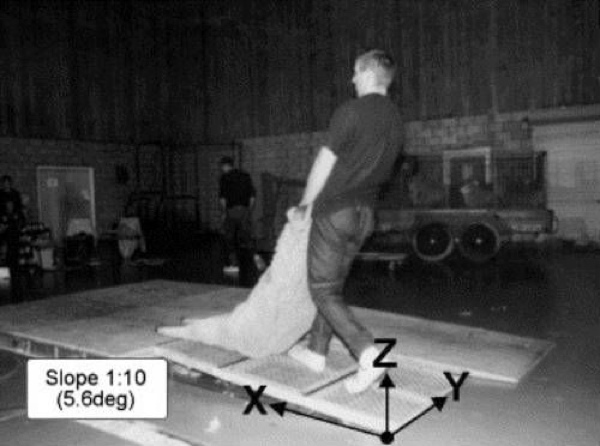 Weird Stuff
Weird Stuff  Weird Stuff
Weird Stuff  Our World
Our World 10 Ways Your Christmas Tree Is More Lit Than You Think
 Movies and TV
Movies and TV The 10 Coolest Stars to Set Sail on The Love Boat
 History
History 10 Things You Didn’t Know About the American National Anthem
 Technology
Technology Top 10 Everyday Tech Buzzwords That Hide a Darker Past
 Humans
Humans 10 Everyday Human Behaviors That Are Actually Survival Instincts
 Animals
Animals 10 Animals That Humiliated and Harmed Historical Leaders
 History
History 10 Most Influential Protests in Modern History
 Creepy
Creepy 10 More Representations of Death from Myth, Legend, and Folktale
 Technology
Technology 10 Scientific Breakthroughs of 2025 That’ll Change Everything
 Weird Stuff
Weird Stuff Ten Bizarre Facts About The Doge Meme
 Our World
Our World 10 Ways Your Christmas Tree Is More Lit Than You Think
 Movies and TV
Movies and TV The 10 Coolest Stars to Set Sail on The Love Boat
Who's Behind Listverse?

Jamie Frater
Head Editor
Jamie founded Listverse due to an insatiable desire to share fascinating, obscure, and bizarre facts. He has been a guest speaker on numerous national radio and television stations and is a five time published author.
More About Us History
History 10 Things You Didn’t Know About the American National Anthem
 Technology
Technology Top 10 Everyday Tech Buzzwords That Hide a Darker Past
 Humans
Humans 10 Everyday Human Behaviors That Are Actually Survival Instincts
 Animals
Animals 10 Animals That Humiliated and Harmed Historical Leaders
 History
History 10 Most Influential Protests in Modern History
 Creepy
Creepy 10 More Representations of Death from Myth, Legend, and Folktale
 Technology
Technology 10 Scientific Breakthroughs of 2025 That’ll Change Everything
10 Ridiculously Unnecessary Scientific Studies
Scientists are the upper echelon of humanity. Through a complex dance of measuring, observing, test tubing, pouring liquids, pouring liquids into something else, cackling through thunderstorms and glove shopping, they provide the life-changing solutions to the problems nobody knew we had. Sometimes though, scientists embark on research that just seems absolutely unnecessary, like the examples below. We tried to only choose studies that were supposed to be serious, but we also don’t understand science jokes, like when someone says that Schrodinger’s cat walked into a bar, or maybe it didn’t, so it’s possible that we missed something with these too. Otherwise, enjoy.

The Study: Testing the Infinite Monkey Theorem
According to the laws of probability, if an infinitely large group of monkeys is given an infinite number of typewriters and infinite time, eventually they’ll create the entire works of Shakespeare. This is known as the Infinite Monkey Theorem.
Completely misunderstanding the theory, a group of researchers in England gave six monkeys one typewriter, which inspired them to create one broken typewriter covered with poop. It started out well: “The lead male got a stone and started bashing the hell out of it,” according to one of the researchers. “Another thing they were interested in was in defecating and urinating all over the keyboard.”
Eventually though, the monkeys got the hang of it and at the end of the experiment they had created five pages of the letter “S.” But, after a week or two the monkeys would get excited when a letter appeared in response to something they had typed, which shows that they might have had some very basic understanding of the cause and effect of what they were doing. And that’s actually pretty cool.

The Study: Trojan US 2011 Sex Census
Not satisfied with your sex life? Move to San Francisco! According to the 2011 Sex Census, a phrase invented and exclusively used by people at Trojan condoms, people who live in San Francisco have more sexual partners than anybody else in the country, with an average of 30 partners per person. Based on that math, you’ve had sex with everybody else on your block, and so has everybody else on your block.
However, if you’re looking for frequency you’d have better luck in Los Angeles where residents average 135 adult hugs each year, because what else are you going to do in all that traffic? But in all seriousness, this might be the most poorly conducted study in recent history. Only 2,000 people were surveyed—200 in each of 10 cities—representing about .00064 percent of the entire US population. Beneath everything, it’s really just an attempt to get people interested in a certain brand of condoms.

The Study: The First Case of Homosexual Necrophilia in the Mallard Anas Platyrhynchos
Dutch scientist C.W. Moeliker is most well-known in the scientific community for being the first person to prove, beyond a shadow of a doubt, that ducks have homosexual intercourse with other duck corpses.
This was not a planned study, simply an observation that he made outside his window one morning, before writing up a full case study of the event and submitting it to a well-respected scientific journal. After hearing a crash, Moeliker walked to the window and noticed a mallard lying outside that had apparently flown into the window. Then, and this is the important part, a second mallard swooped down and “mounted the corpse and started to copulate, with great force.”
After watching for probably only a few minutes, Moeliker went outside and picked up the dead duck while the second duck stood a few feet off and quacked in resentment. He then meticulously recorded the dead duck’s measurements, threw it in the freezer, and, like some sort of bizarre judge sentencing a rapist, came to the conclusion that “one may argue that the copulation was not rape, but the act was non-consensual anyhow.”

The Study: Pressures Produced When Penguins Pooh—Calculations on Avian Defection
In the year 2003, North Korea revealed that it had nuclear weapons, Catherine Zeta-Jones won an Oscar, and two scientists spent a few months calculating the velocity of penguin poop. While all of those are surprising and at least two are true, only one of them makes absolutely no sense.
Based on the observation that penguins will forcibly expel their fecal matter away from them, Dr. Victor Benno Meyer-Rochow and his partner Jozsef Gal set out to calculate just how much force it actually takes. In their final paper—which has more synonyms for “poop,” “spray,” and “poop” (the verb) than most dictionaries—they came to the conclusion that a penguin will poop with about four times the pressure of a human, and can spray it as far as 40cm away from their body.
Even more incredible, a lot of it depends on the type of poop the penguin is dealing with. If it’s “watery,” the pressure probably won’t be higher than 77 mmHG. For something with “the viscosity of olive oil,” you’re looking at closer to 450 mmHG of pressure.
Unfortunately, the study doesn’t wind up telling the whole story, and ends with something of a cliffhanger: “Whether the bird deliberately chooses the direction into which it decides to expel its faeces or whether this depends on the direction from which the wind blows at the time of evacuation are questions that need to be addressed on another expedition to Antarctica.”

The Study: Bust Size and Hitchhiking: A Field Study
Imagine a world where all breasts are the same size. It would be chaos, or worse, mildly frustrating, and it would make hitchhiking entirely too repetitive. Because as Nicolas Gueguen discovered in 2007, men are more likely to pick up female hitchhikers who have larger breasts.
In a mad rush to prove the obvious, Prof. Gueguen stationed a young female beside a road in France and waited while 1,200 people stopped to pick her up. The woman was wearing a bra that could be adjusted to change the appearance of her bust size, and 24 percent of the passing male motorists offered her a ride when it was set to C, compared to only 17.79 percent for the B cup and 14.92 percent for A. In a surprising Kafkaesque twist, women showed no preference.

The Study: An Analysis of the Forces Required to Drag Sheep Over Various Surfaces
How much force does it take to drag a sheep? I know what you’re thinking, but it’s not a simple matter of Ft = ma—(?)(-mg). Duh, right? Because that barely factors in those times when you need to drag a sheep over sand. Or linoleum. Or, relevantly, wool, the Inception of sheep pulling. Where does one sheep end and the other begin? These are questions that demand answers. And answers are what we have been given
In 2002, a team of seven researchers set out to figure out exactly what the ideal surface was for dragging sheep. The reasoning behind the study was that sheep shearers often have to drag a sheep out of the holding pen, and doing so can cause back problems. So if the sheep was easier to pull, it could reduce some of the health concerns.
They tested five different surface types, cross-checked them against variables like the angle of the floor, and came up with what they claim to be the ideal surface. In case you’re wondering, and we know you are, the perfect floor to pull a sheep across is “a sloping surface (1:10 as tested) constructed of wooden battens arranged parallel to the direction of the drag.” So don’t say Listverse never taught you anything.

The Study: People With Dark Personalities Tend to Create a Physically Attractive Veneer
Why is it sexy to be the “bad boy?” As it turns out, it’s all about the clothes they wear. Nicholas Holtzman and his research team tested 100 people for what psychologists call the Dark Triad—Machiavellianism, psychopathy, and narcissism. They found that people who displayed those three traits were more likely to dress in a way that attracts attention, and that alone lends them their seductive lure.
Pictures of the participants—the people who took the personality test—were given to volunteers who were asked to rate their attractiveness. In one set of pictures the participants were wearing their normal clothing, and in another set they were displayed as neutrally as possible—sweatpants, tee-shirts, no makeup. The people with dark traits were consistently rated hotter in their normal clothes than in their neutral clothes, while the people who didn’t have dark traits were about the same no matter what they wore.
According to the researchers, the difference was the Dark Triads worked harder on their appearance to create a better first impression, and that made them more attractive. So the lesson to take away from this is, hot people are psychopaths.

The Study: Unethical Behavior Tied to Attitudes Toward Greed
Apparently, rich people are greedy, lying cheaters. This is something every poor person knows and every rich person lies about, but finally we have proof. According to the National Academy of Sciences, members of the upper class are more likely to act out of self-interest than members of lower classes.
They created their report from a series of studies that tested the moral ambiguity of members of different social classes. One study pitted participants of different social classes in a game – a computer simulation rolled a die five times, and they were told that they would win more cash with higher numbers. What they weren’t told was that the total sum would always be 12. Afterwards, participants reported the sum of all the rolls. The wealthier participants were much more likely to cheat and say something higher than 12.
Other studies showed that rich people were more likely to cut off other cars, run through crosswalks instead of waiting for pedestrians, and even take more candy out of a jar after being told that what they didn’t take would go to children. Basically they were just being all-around jerks. Go figure.

The Study: Spontaneous Knotting of an Agitated String
This link leads to a six page document explaining why string will form knots when you put it in a box and shake it. It has graphs, charts, detailed diagrams of knotted string, and tables discussing the pros and cons of shaking a piece of string in different sized boxes. The description under one of these tables explains that “the percentages were determined from 200 trials.” From my limited understanding, I think that means they shook a box filled with string 200 times, although I hope I’m wrong.
The problem with this study is not that the researchers were studying knots; it’s that there’s no discernible reason for them to do so. Nowhere does the study mention any form of goal, and the closest thing in the paper to a thesis statement is “We investigated the probability of knotting, the type of knots formed, and the dependence on string length.” On the other hand, knot theory has been around for awhile and it’s believed that it could have some bearing on the way DNA behaves, so yeah, any extra research could come in handy. It just seems really silly.

The Study: Chickens Prefer Beautiful Humans
Ugly people take heed: chickens dislike you. In one of the most unnecessary studies ever, researchers trained chickens to react to human faces of the opposite sex—hens were trained to react to male faces, and cocks to female faces (be mature). The pictures were displayed on a touch-sensitive screen, and reactions were measured by the number of times the chicken pecked the screen.
Then, and this is where it gets weird, the researchers began to insert “more attractive” faces into the picture rotation—faces that had previously been rated on attractiveness by human volunteers. Without a single variation, the chickens got more excited about the attractive faces than anything else, giving extra preference to the exact same faces that the humans rated as most attractive.
What does it mean? Even the researchers aren’t sure. Maybe the chickens were just from San Francisco.








